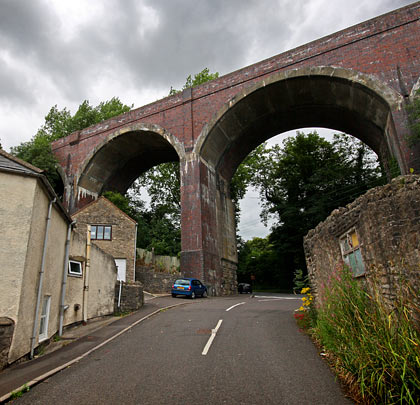Bath Road Viaduct
Bath Road Viaduct






















Prompted by the Midland Railway’s arrival in Bath in 1869, the Somerset & Dorset developed proposals for a connection between the city and its main line at Evercreech. Authorised by Parliament in August 1871, its single track opened for business less than three years later.
The skills of its engineers were tested around Shepton Mallet where serious structures were demanded – a tunnel beneath Windsor Hill and three viaducts. The longest of these, close to the station, involved 27 arches whilst the tallest was a six-span crossing of Bath Road, located half-a-mile north of the town centre. 75 feet high and 118 yards long, structure number SAD/81 was masonry built but with brick arches, 50 feet in span. North-to-south, the line over it encountered a falling gradient of 1:70.
The overwhelming success of the Bath Extension brought with it plans to increase capacity by adding a second track. The section northwards to Binegar was completed in 1892. For Bath Road Viaduct, this involved widening it on its western side, work which was carried out in brick. Each arch comprised seven rings, with an additional one turned on the original viaduct to match.
The junction between these two separate structures was a cause of ongoing problems, leaking water and opening slightly. Incremental repairs took place. A full inspection was carried out in January 1946, prompted by a further widening of the joint. Whilst a remedial programme was being developed, the structure moved again causing single line working to be instituted over the Down line, carried by the older viaduct.
On the morning of Friday 1st February, the middle pier of the new section gave way, taking with it the arches on either side. Fortunately, no trains were crossing and no road traffic was passing beneath; nearby houses were unaffected. But, by the following day, trains were running again across the viaduct, with the single line slewed across towards the remaining parapet and a temporary speed restriction imposed.
Rebuilding work was quickly put in hand, with normal movements resuming on 1st August and linespeed restored six weeks later. The concrete piers were faced in brick and took three weeks to erect, whilst the new three-feet thick arches were cast in concrete sections in just a fortnight. Undertaken by William Cowlin & Sons, the project cost £26,000 and their efforts are commemorated by a roadside plaque. The same company was responsible for further remedial works to the original piers, a consequence of severe frosts the following winter.
The Somerset & Dorset saw its last train on 5th March 1966 and the viaduct received a Grade II listing in September 1984. It is currently being looked after by BRB (Residuary). In October 2010, the Board was given the go-ahead to carry out repairs to the structure including rewaterproofing the deck, fitting new drainage pipes and erecting 3m security fences at either end.







